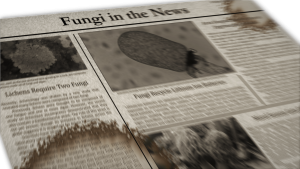#221: Massospora cicadina
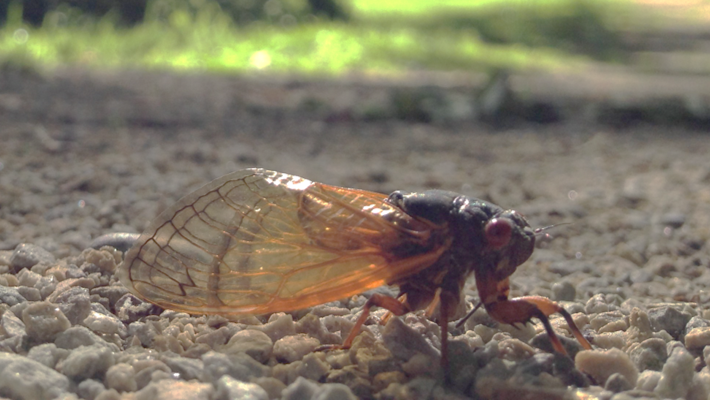
The fungus Massospora cicadina infects periodical cicadas and causes their abdomens to fall off. The cicada in the picture is still alive, despite its missing body segments. Public domain image.
It’s hard being an insect. Despite being numerous, insects have many predators, have to deal with human pesticides and cars, and are susceptible to dreadful fungal pathogens. Some of these entomopathogenic fungi take control of their hosts’ bodies in innovative but disturbing ways. One such fungus is Massospora cicadina, which infects periodical cicadas (Magicicada spp., which appear in eastern North America every 13 or 17 years). After spending over a decade in the soil waiting for its hosts to emerge, the fungus infects the cicadas and causes their abdomens to pop off. The cicadas then fly around and try to mate with each other, spreading the fungal infection both through the air and through contact. It’s hard to imagine a more horrific sexually transmitted infection, even in the insect world.1–4
Periodical Cicadas
Periodical cicadas (Magicicada spp.) are amazing insects. Although cicadas are present in most parts of the world, periodical cicadas are found in only eastern North America.5 These insects spend most of their remarkably long lives underground, sucking on plant roots. Specifically, cicada nymphs use their mouthparts to tap into the xylem of tree roots. Xylem is one of the two main transport systems found in vascular plants and is designed to transport water and nutrients. The other is phloem, which transports energy-rich sugars. Since cicadas feed on energy-poor xylem contents, they mature slowly.6
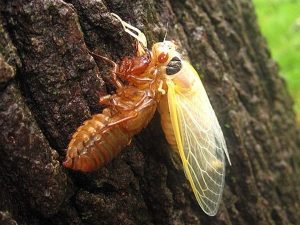
Periodical cicadas spend most of their lives underground. After 13 or 17 years underground, the cicadas emerge. The photo above shows a newly emerged cicada before its skin has hardened. Photo by Futureman1199 [CC BY-SA 3.0 ], from Wikimedia Commons.
Another remarkable aspect of the periodical cicada’s life cycle is that when they are ready to reproduce, each brood emerges at once, sometimes in just one day. In spring, the nymphs crawl out of the ground and make their way a short distance up tree trunks or vegetation. There they stop and shed their exoskeleton a final time, becoming winged adults.9 Once their new skin hardens (in about four to six days), they fly off to mate, lay eggs, and die over the course of a few weeks.5,9 During this time, every acre in a brood’s territory may have a million or more of the bulky insects flying around at the same time.9
To find a mate, males make loud rasping calls using organs called tymbals and females flick their wings in response.7,9 Once they mate, females lay their eggs in tree branches. When the eggs hatch in six to ten weeks, the nymphs fall to the ground and burrow down to begin sucking on tree roots.9
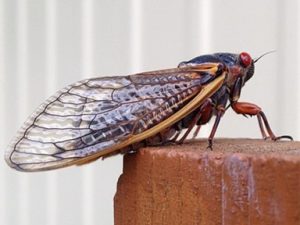
Adult cicadas emerge all at once, with hundreds of thousands to millions of individuals in each acre. This ensures predators will not be able to eat all of them. Public domain image.
The bizarre mass emergence of periodical cicadas benefits the insects by overwhelming predators. Since periodical cicadas emerge en masse, there is no way for birds, fish, cats, or other predators to eat them all – a strategy called “predator satiation.” After the predators have eaten their fill of cicadas, the remaining cicada population can go about its business unencumbered.6,7,9
Additionally, the extremely long periods between emergences mean that periodical cicadas have no specialized predators.6,9 All predators of periodical cicadas survive on other insects during the years between emergences (cicada killer wasps, for example, eat annual cicadas most of the time10). However, they still have to deal with one specialized parasite: the fungus Massospora cicadina. This fungus is the only organism with a life cycle synchronized to that of the periodical cicadas, a remarkable feat considering that the fungus must wait in the soil for over a decade before infecting new cicadas.2,6,9
Massospora cicadina Life Cycle
To cope with its host’s unusual life cycle, M. cicadina has evolved a unique life cycle of its own. The fungus requires two infection stages to complete its life cycle. The first – stage I – affects cicadas just after they emerge and is designed to transmit the fungus to other cicadas. Stage II affects cicadas later on and is designed to spread spores that will persist for the next 13-17 years around the ground. Both stages must be completed before the end of the month when the last adult cicadas die.1,3,4
Stage I
The first stage begins as the cicadas are emerging. As they dig up through the soil, the nymphs encounter fungal spores that attach to and begin infecting the insects. Initially, the fungus grows inside the cicada and it is hard to tell that it is infected. Both males and females are infected and roughly 2-5% of the emerging nymphs contract the fungus. M. cicadina primarily infects tissue in the cicada’s abdomen, which renders its host sterile. The fungus quickly fills the cicada’s abdomen with haploid conidiospores. Eventually, the cicada’s abdomen becomes so full of spores that the last two body segments break off, exposing the white powdery spores. This is not fatal for the cicada, which continues flying around and spreading the infection.1,3,4
In stage I, M. cicadina spreads primarily as a sexually transmitted infection. Both female and male cicadas infected with the fungus will try to mate with other cicadas. Since they are sterile, these attempts are unsuccessful but they do transfer fungal spores to new hosts. This can be before or after the abdomen falls off – cicadas aren’t smart enough to figure out that sex doesn’t work when your partner’s rear end is missing. Presumably the spores can also be transferred through the air while infected cicadas are flying around with a mass of spores where their abdomens should be, although this is not the primary mode of transmission.1,3,4
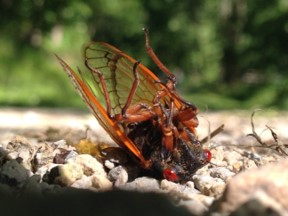
There are two stages of M. cicadina infection. In both stages, the fungus bursts out of the cicada’s abdomen while the cicada is alive. Public domain image.
Recently, researchers discovered that the M. cicadina modifies the behavior of male cicadas to encourage spreading fungal spores through sexual encounters. To do this, the fungus forces male cicadas to behave more like females. Instead of calling like normal males, infected males perform wing flicks as if they were female cicadas. This attracts male cicadas, who try to mate with the infected males. Unfortunately, all the males get out of the encounter is a fungal infection. But M. cicadina doesn’t stop there; it encourages the infected males to try and mate with female cicadas, thus spreading the infection to females as well.1,3,4
In another recent study, scientists identified the psychoactive compounds psilocybin (a hallucinogen, see FFF#098) and cathinone (an amphetamine) in Massospora-infected cicadas. These compounds are present in high concentrations for cicadas but relatively low concentrations in humans (you would need to eat about a dozen infected cicadas in order to get high, although I wouldn’t recommend trying that given how little we know about any other chemicals that might be in the diseased cicadas). Presumably, these compounds play a significant role in keeping the cicadas happy and mating despite missing their genitals and a significant portion of their body.11
Stage II
Stage II infections are found in cicadas that contracted the infection after they emerged; in other words, the unfortunate ones who caught a sexually transmitted infection from another cicada. The disease progresses in the same way it does in stage I: the fungus consumes the cicada’s abdominal tissues, produces spores in the abdomen, and causes the cicada’s last couple body segments to fall off. In stage II, however, the fungus does not modify its host’s behavior. Additionally, it produces diploid resting spores that are designed to survive long periods in the soil but do not spread infection between cicadas. Instead, the spores are slowly released into the air as the cicada flies, thereby falling to the ground near where cicadas are likely to emerge during the next cycle.1,3,4 This has earned the fungus-infected cicadas the nickname “Flying Saltshakers of Death.”8,11
Meiosis
Now we come to a topic that mycologists don’t know much about. Stage I produces haploid conidiospores (a type of spore produced through mitosis) and stage II produces diploid resting spores (also produced through mitosis). Both known spore stages of M. cicadina are produced asexually. And yet, the fungus’ life cycle includes both haploid and diploid stages. At some point, the fungus must carry out sexual reproduction, although there is no obvious time at which this would happen.
Meiosis probably occurs sometime before or during stage I. A likely option would be that the diploid resting spores germinate in the spring of the 13th or 17th year, carry out meiosis, and release haploid sexual spores. In this model, it is the sexual spores that would infect the emerging nymphs. Another possibility is that meiosis occurs in the cicada’s abdomen. In this model, the fungus would produce sexual spores which would then carry out mitosis to produce the infective conidiospores. Mycologists tend to be nitpickers (it’s inevitable, since fungi produce so few observable structures), so I think they would have recognized two different spore types while observing half dead cicadas. Consequently, I think the first option (that meiosis occurs in the soil) is more likely.
Fungal mating is a bit easier to pin down. It must occur sometime during stage II, since haploid spores are produced in stage I. Once these spores land on a host, they will probably begin infecting that host. After a while, the nascent infection will encounter hyphae from another haploid spore. If the two hyphae are sexually compatible, they will fuse together. Once fused, the hyphae will grow to form a mycelium that is either dikaryotic or diploid. Most fungi do not produce diploid cells until just before meiosis, so it is more likely that the mycelium will remain dikaryotic until it begins producing the diploid resting spores.
If you didn’t understand much of what I just said, don’t worry – it was all speculation anyway. The fact is that we know nothing about M. cicadina’s sex life. However, it does appear to be linked to the two stages of infection. The stage of sexual reproduction seems to determine the stage of infection. This is very similar to how rust fungi (see FFF#130) operate. Although this would be a fascinating organism to study, its extremely long life cycle (during which most of the activity takes place in a matter of weeks) makes it difficult to observe the fungus.
Taxonomy
M. cicadina belongs to the division Entomophthoromycota.12 This division was erected recently13 and contains mainly entomopathogenic fungi. When researchers found psilocybin in infected cicadas, that result was unexpected. Previously, only fungi from the divisions Basidiomyocta and Ascomycota were known to produce psilocybin. Did fungi in these three divisions learn to produce psilocybin independently of one another or did they share an ancient common ancestor that could also produce psilocybin?11 Either way, this makes the evolution of M. cicadina a fascinating research topic.
| Common Name | Salt Shakers of Death Fungus | Cicada |
| Kingdom | Fungi | Animalia |
| Subkingdom | Zoopagomyceta | Bilateria |
| Infrakingdom | Protostomia | |
| Superdivision/ Superphylum | Ecdysozoa | |
| Division/ Phylum | Entomophthoromycota | Arthropoda |
| Subdivision/ Subphylum | Entomophthoromycotina | Hexapoda |
| Class | Entomophthoromycetes | Insecta |
| Subclass | Pterygota | |
| Infraclass | Neoptera | |
| Superorder | Paraneoptera | |
| Order | Entomophthorales | Hemiptera |
| Suborder | Auchenorrhyncha | |
| Infraorder | Cicadomorpha | |
| Superfamily | Cicadoidea | |
| Family | Entomophthoraceae | Cicadidae |
| Subfamily | Cicadettinae | |
| Tribe | Taphurini | |
| Subtribe | Tryellina | |
| Genus | Massospora | Magicicada Davis14 |
| Species | Massospora cicadina Peck12 | Magicicada spp. |
See Further:
https://www.nature.com/articles/s41598-018-19813-0
https://www.sciencealert.com/parasitic-cicada-fungus-zombie-sexually-transmitted-massospora-cicadina
https://www.sciencedaily.com/releases/2018/02/180222103556.htm
https://blog.mycology.cornell.edu/2013/02/19/flying-salt-shakers-of-death/
https://www.theatlantic.com/science/archive/2018/07/massospora-parasite-drugs-its-hosts/566324/
http://bugoftheweek.com/blog/2013/6/17/std-in-cicada-land-imagicicadai-and-imassospora-cicadinai
https://entomologytoday.org/2014/07/29/periodical-cicadas-in-iowa-summer-of-2014/
http://www.cicadamania.com/cicadas/the-most-interesting-17-year-cicada-facts/
Citations
- Cooley, J. R., Marshall, D. C. & Hill, K. B. R. A specialized fungal parasite ( Massospora cicadina ) hijacks the sexual signals of periodical cicadas (Hemiptera: Cicadidae: Magicicada ). Scientific Reports 8, 1432 (2018).
- Raupp, M. J. STD in cicada land, Magicicada and Massospora cicadina. Bug of the Week (2013). Available at: http://bugoftheweek.com/blog/2013/6/17/std-in-cicada-land-imagicicadai-and-imassospora-cicadinai. (Accessed: 3rd August 2018)
- Starr, M. This Horrifying Fungus Hijacks Cicadas Before Exploding From Their Butts. ScienceAlert (2018). Available at: https://www.sciencealert.com/parasitic-cicada-fungus-zombie-sexually-transmitted-massospora-cicadina. (Accessed: 3rd August 2018)
- University of Connecticut. Invasion of the body-snatching fungus: Researchers have recently documented strange behavioral changes in male cicadas infected with a fungus called Massospora cicadina. ScienceDaily Available at: https://www.sciencedaily.com/releases/2018/02/180222103556.htm. (Accessed: 3rd August 2018)
- Periodical cicadas. Wikipedia (2018).
- Ballenger, J. Periodical Cicadas in Iowa, Summer of 2014. Entomology Today (2014). Available at: https://entomologytoday.org/2014/07/29/periodical-cicadas-in-iowa-summer-of-2014/. (Accessed: 3rd August 2018)
- Dan. The most interesting 17 year cicada facts. Cicada Mania (2013).
- Macias, A. Flying salt shakers of death. Cornell Mushroom Blog (2013).
- Cooley, J., Marshall, D. & O’Brien, M. Periodical Cicada. The University of Michigan Museum of Zoology, Insect Division (2016). Available at: http://insects.ummz.lsa.umich.edu/fauna/. (Accessed: 3rd August 2018)
- Dan. 10 Facts about Cicada Killer Wasps. Cicada Mania (2015).
- Yong, E. This Parasite Drugs Its Hosts With the Psychedelic Chemical in Shrooms. The Atlantic (2018). Available at: https://www.theatlantic.com/science/archive/2018/07/massospora-parasite-drugs-its-hosts/566324/. (Accessed: 3rd August 2018)
- Massospora cicadina. Mycobank Available at: http://www.mycobank.org/name/Massospora%20cicadina&Lang=Eng. (Accessed: 3rd August 2018)
- Entomophthoromycota. Mycobank Available at: http://www.mycobank.org/BioloMICS.aspx?TableKey=14682616000000067&Rec=482537&Fields=All. (Accessed: 3rd August 2018)
- Magicicada Davis, 1925. Integrated Taxonomic Information System Available at: https://www.itis.gov/servlet/SingleRpt/SingleRpt?search_topic=TSN&search_value=846740#null. (Accessed: 3rd August 2018)

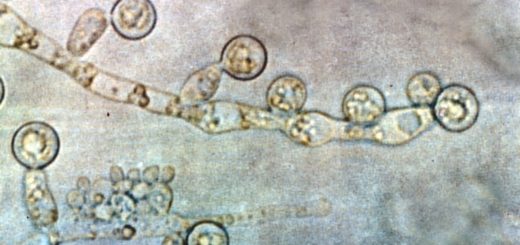

![#013: Characteristics of Phylum Basidiomycota [Archived]](https://www.fungusfactfriday.com/wp-content/themes/hueman/assets/front/img/thumb-medium-empty.png)





![#011: Characteristics of Kingdom Fungi [Archived]](https://www.fungusfactfriday.com/wp-content/themes/hueman/assets/front/img/thumb-small-empty.png)

